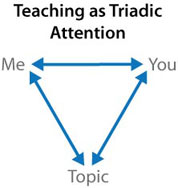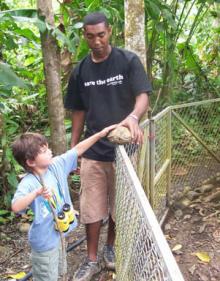Bring Out the Teacher in Your Students
“Look, Mom! See the turtle! He is scaly!”
Spend a day with a small child, and you will hear many such observations. That’s because all of us have an innate human desire to teach. Somehow what we learn isn’t real until we share it with someone else.
“Watch what I can do! Let me show you how!”
The exclamation points are almost mandatory, because we want to teach. “Show and tell” is one of the most popular times in elementary school—the chance for students to become teachers. And much of the appeal of social media is allowing middle and high school students to share what they have discovered.
“I want to show you something. You’ll never believe this—it’s so COOL!”
Teaching—Unique to Our Species
You’ve heard the expression, “Monkey see; monkey do.” It’s quite literally true. Great apes learn by mimicking what they see, but they don’t actively teach. Why not?

The act of teaching requires “triadic attention.” When you teach, you have to pay attention to three things—yourself, the other person, and the topic you are teaching. If you lose track of any of the three parts, the teaching moment is lost. Triadic attention is a hat trick that other species can’t maintain for long. Human beings, however, are capable of this feat even before they can speak. That’s why toddlers do so much pointing—to teach you about what they are seeing. Teaching is so central to who we are that perhaps our species should be renamed Homo pedagogues.
5 Strategies to Harness Students’ Desire to Teach
You may have heard about being the lead learner in your classroom. Now think of yourself as the lead teacher. Invite your students to step up and teach. Give them assignments that require them to do so. Here are five strategies for harnessing your students' desire to teach, starting with simple techniques and moving to greater levels of student contribution.
- Activate prior knowledge: When you start on a new topic, ask students to explore what they already know about it and to share their knowledge with the rest of the class.
Students can . . .
- write and recite a paragraph about what they know.
- verbally volunteer facts about the topic.
- describe where they learned what they currently understand.
- create a KWL chart, listing what they know and what they want to find out—then share with partners.

See page 162 in Inquire: A Guide to 21st Century Learning.
Download a free KWL Chart template in Word. - Find something interesting: Instead of having students passively receive information, make them actively grab it. Assign them to “find something interesting” in the subject and to share what they find with the class.
Students can . . .
- page through a new chapter and look for something interesting in the material—a photo, caption, heading, or piece of text—and then report on it.
- research a specific topic and teach the class what they have discovered.
- return to material already covered and find something interesting to reemphasize to the group.
- find and share a real-world application of ideas they have learned.
- Invent a solution: Focus students’ attention on a particular problem in the subject you are teaching. Then pair up students to come up with ways to solve the problem. Of course, have them teach the rest of the class about what they invent.
Students can . . .

See page 421 in Inquire: A Guide to 21st Century Learning.
- Write and present legislation to solve a current or past issue in social studies.
- Design and run a campaign in order to promote a cause.
- Devise and conduct an experiment to test a certain idea in science.
- Build and use an equation that can solve a real-world problem.
- Create and distribute a survey to discover readers’ views of a specific novel.
- Organize and lead a team to accomplish a community task.
- Develop and present a public-service announcement to bring awareness to a key issue.
- Tutor each other: Check comprehension of new concepts by asking students to rate their progress on the following scale, which is based on a growth mindset.

Then pair students in tutoring groups. Here are some options for collaborative tutoring:
- Partner tutors: 1s pair with 2s, and 3s pair with 4s. (Those who are at a similar level work together to improve.)
- Mentor tutors: 1s pair with 3s, and 2s pair 4s. (Students who are further along can mentor those who are getting going.)
- Intervention tutors: 1s pair with 4s, and 2s pair with 3s. (The advanced learners mentor the beginning learners, and the middle students learn as partners.)
- Teach the class: Ask students to perform tasks that you routinely do. By assigning them to step forward, you get to step back. And, of course, the best way for a person to learn a topic is to teach it.
Students can . . .
- lead a preview of a new chapter by flipping through it and noting topics.
- write suggestions on the board.
- call on other students during a class discussion.
- prepare and deliver an introduction to new material.
- create a quiz that covers material learned.
- lead a review of material covered.
- lead test-prep before a major assessment.
- build a rubric that connects standards to an upcoming project.
I Teach, Therefore I Am.
It has been said that civilization is always one generation away from barbarism. Teachers save civilization every time—passing culture and knowledge to a new generation. That’s why the most beautiful sight in the world is the dawning look on the face of a student who just “got it.” Your students want to bring that look to others’ faces. Invite them to become teachers. You’ll quickly discover that they want to teach as much as you do.
We want to hear from you. Did you get a chance to teach when you were a student? Do your students get chances now? What strategies do you use to help your students teach? Please enter comments below.



Comments
Students as Teachers
Hi Rob,
As usual, a blog post full of ideas that can be applied in any classroom. The only observation I have is that not all students might be engaged in this type of activity (some are introverts, like me) - which is fine as long as the teacher does not "push" them into it.
Thank you for sharing.
Nice Observation!
Hi, Cristina:
It's always great to hear from you!
I agree. I'm an introvert myself, so the last thing I would want is to be pushed into doing something that made me feel unsafe. Having said that, though, I still am eager to share when I have learned something new. Perhaps providing another avenue for teaching could help such students. For example, I know that having students collaborate using Google Docs often helps the shy ones participate in writing when they would be too nervous to do so out loud--just a thought.
Maybe other teachers have some suggestions for making it safe for even shy students to do some teaching.
Thanks so much for your comment!
Rob
Students Being Given a Chance to Teach
I give my students many opportunities to teach. One of the ways I use often is letting my students go up to the Smartboard and show their strategy for solving a Math problem. I record it ,save it, and post it on Edmodo. Now that I have an Ipad we use Educreations.
Great Application!
Hi, Lisa:
Thanks for commenting. What a great way to invite your students to teach--and then to turn around to share their work on Edmodo! We live in a participatory culture, so all of us are teachers and learners, readers and writers, consumers and producers of information. By letting your students teach and then sharing what they teach, you aren't just preparing them for their future lives. You're making your classroom relevant to their current lives. Thanks for sharing!
Rob
Post new comment